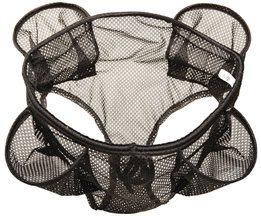Lifesaving Equipment
The right equipment makes all the difference in your training and teaching success. In this section we go into more detail to help your teams decide on their needs.
With the right kit, you are always ready for immediate action. Below is a list of some useful equipment you should have to hand during lifesaving or survival training.
- First Aid Kit
- Whistle
- Lifevest
- Reaching pole
- Throw line
- Torpedo buoy
- Buoyant items like cans or balls
- Ring buoy (don't throw this at people, it hurts)
- Spinalboard with tie-down straps (where available)
Make sure all gear is in top condition, works well and has no loose or dangerous bits sticking out.
Spinalboard
The use of the spinalboard requires special training.
It is not something you can learn from a website.
Please contact your local Red Cross or equivalent for training courses.
Throwable Devices
Throwable floats are designed for areas where there is constant boat traffic and rescue is immediate. They are commonly ring-shaped, but horseshoe and cushion type floats are also made.
These are only a backup measure and should generally be thrown by someone with experience, as it is difficult to aim well, especially in rougher water. A cushion-style float has a buoyancy of 8 kg, while a ring-style has a buoyancy of 16.5 kg.
Under some circumstances a throw bag, containing a floating rope to extend a line to a nearby swimmer or boat,
can substitute for a throwable float.
Tow Tethers
For resistance swim training you may want to consider a swim bungee training belt. It attaches to the pool wall and around your waist. As swim forward, it pulls you back against your effort and thus keeps you in one place.
When you want to swim long distances in a small pool without turning, a tow tether can make sense. Instead of moving through water, you move the water past your body. The harder you push, the further it lets you go. When you stop, it pulls you back. The more clothes you wear, the harder your training gets.

Equipment You Don't Need
Apart from useful stuff the swimming industry sells some pointless kit too, often at silly prices. Some devices are downright dangerous. Save your money for something useful.
Drag Suits
Price: ca. €15 to €40
Drag suits capture and hold in water, creating increased resistance as you train so you get a better workout. They are basically like a normal bathing suit, but run LARGE to give competitive swimmers a better drag effect.
Some have extra mesh pockets placed around the waist which gives you even more drag. However, you can't wear them anywhere in polite society.

Drag Chutes
Price: ca. €25 to €30
Designed for resistance swim training, drag chutes increase endurance and strength in all swimmers. Various drag devices can be used with the tow tether by clipping them onto the adjustable lead.
Plastic buckets, water chutes or similar devices can be used as readily available drag. Do not attempt flip turns when towing a bucket or other hard drag devices.
We think that anything you attach to a waist belt and drag behind you is not only a hinderance, but can be a hazard for you and other swimmers who may get entangled in the ropes. Forget it.
Swim Paddles
Price: ca. €10 to €25
For lifesaving and survival swimming you need your hands free. Any paddling devices on your hands may turn out a hindrance or an injury hazand when you come in contact with other swimmers.
Hand paddles should only be used for lap training. They are designed to help you get the most from your swim workout, so you can focus on increasing strength, stamina or tone where it suits you.
It’s probably a bad idea to use these paddles as a beginning or even intermediate-level swimmer. You can hurt yourself! Certain stroke flaws like thumb-first entry, crossing over the mid-line, dropping your elbows on the catch, combined with paddles can lead to rotator cuff injuries.
At the beginning of the pull, the arm and especially the shoulder are in an anatomical weak overhead position. Furthermore, a swimmer’s stroke maybe far from perfect. Putting additional load on the shoulder in this position isn’t such a good idea. It can increase strain and lead to swimmer’s shoulder. There are far better exercises to strengthen the shoulders with dry land training than to use paddles.
Water resistance increases exponentially with speed. So there’s a limit on how much speed you can gain by increasing your strength. It is far more easier and effective to work on tuning drag than to increase strength.
Smart Alternatives
Wear comfy clothing layers, depending on the resistance level you require. Many pools only allow man-made fibres, so choose your kit carefully.
T-shirt: €2 to €10
Hoodie: €10 to €20
Anorak: €10 to €20
Cargo Pants: €15 to €30
Reader Comment
I have just started taking advanced swim training.
Instead of a silly fish net,
I wear T-shirt with swim shorts
or unlined track pants which are not too tight around me.
For strength and resistance swim training I add a hoodie or anorak with matching pants.
This is much more comfortable and looks cool.
- Michael, Toronto